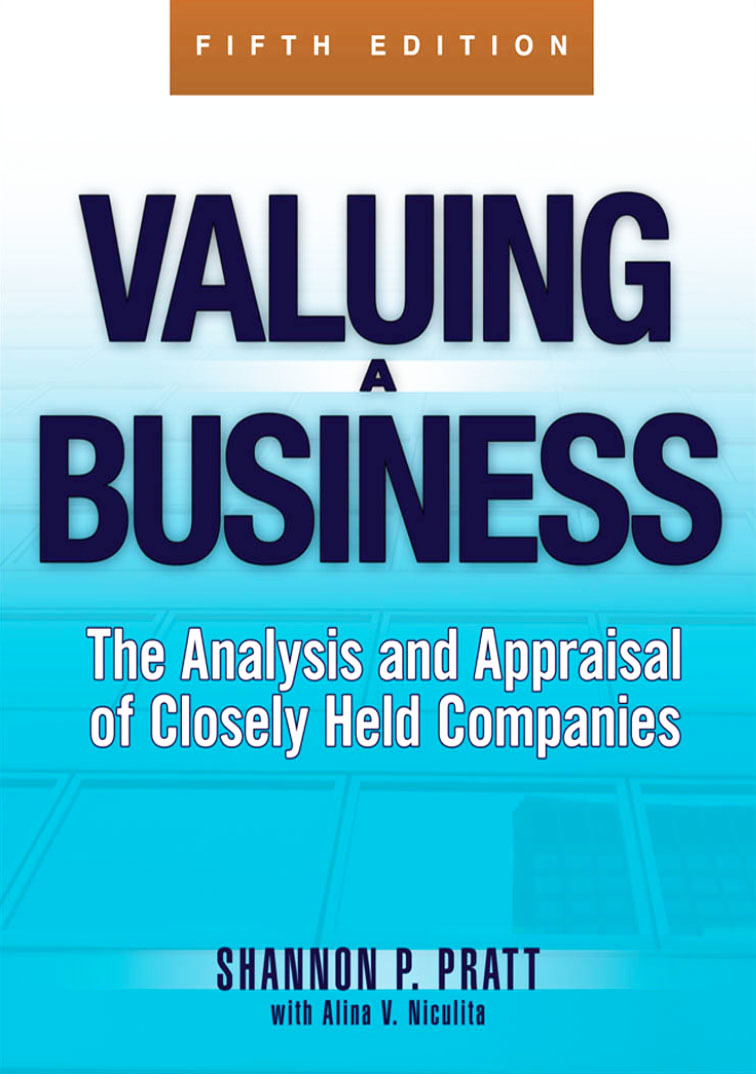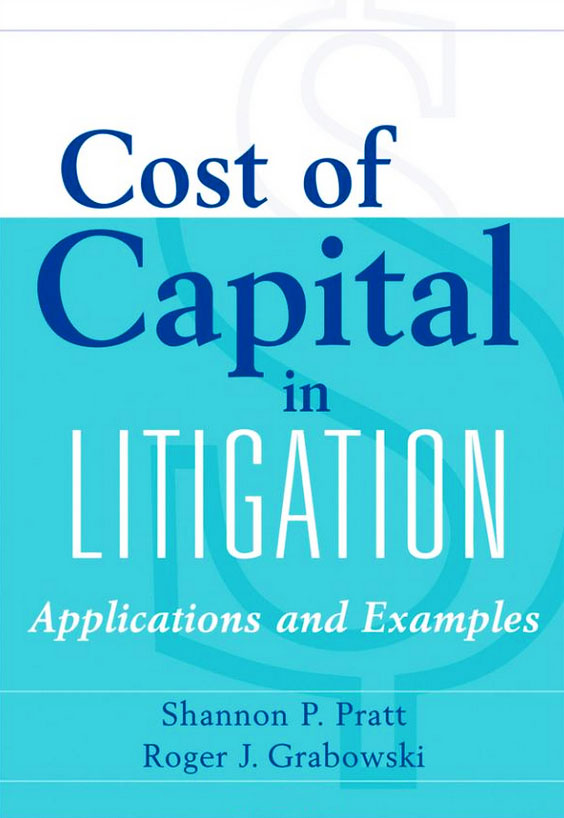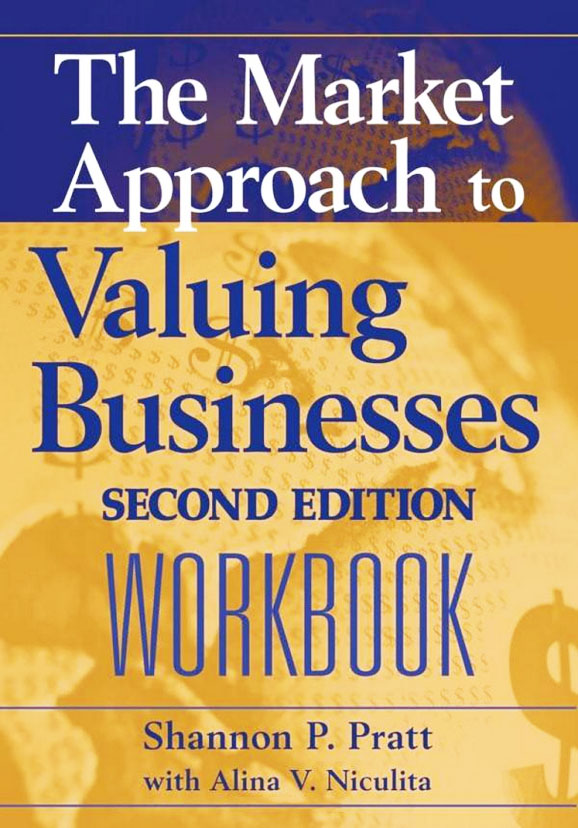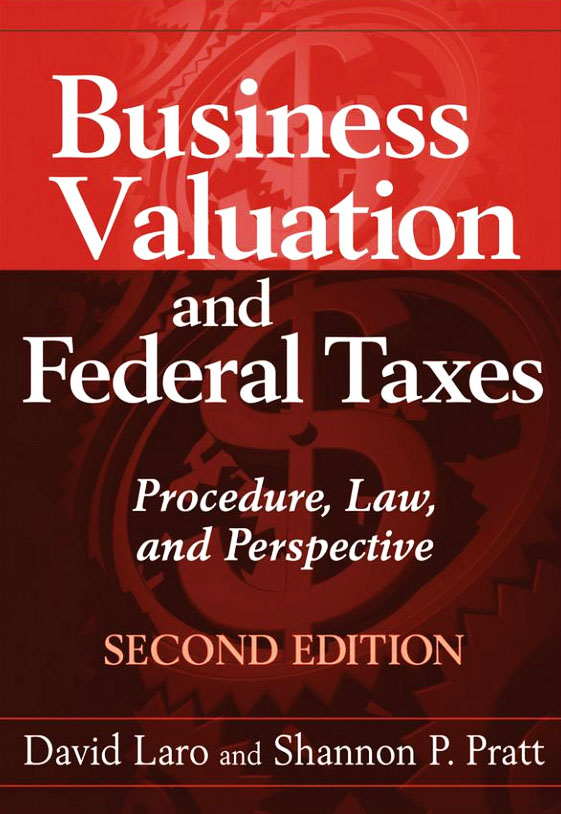Business Valuation Discounts and Premiums, Second Edition
Table of Contents
Chapter 2: Minority Discounts and Control Premiums.
Chapter 3: Empirical Data Regarding Minority Discounts and Control Premiums.
Chapter 4: Minority Discounts and Control Premiums in the Courts.
Chapter 5: Discounts for Lack of Marketability for Minority Interests: Concept and Evidence.
Chapter 6: Synopsis of Restricted Stock Studies.
Chapter 7: Liquistat™ database (Restricted Stocks, warrants and convertible securities).
Chapter 8: Blockage Discounts. Blockage Is Distinct from Restricted Stock.
Chapter 9: John Emory Pre-Initial Public Offering Discount for Lack of Marketability Studies-Complete Underlying Data.
Chapter 10: Valuation Advisors Discount for Lack of Marketability Study.
Chapter 11: Factors Affecting Discounts for Lack of Marketability for Minority Interests.
Chapter 12: Discounts for Lack of Marketability for Controlling Interests.
Chapter 13: The Quantitative Marketability Discount Model A Shareholder Level DCF Model.
Chapter 14: Marketability Discounts in the Courts-Minority Interests.
Chapter 15: Marketability Discounts in the Courts-Controlling Interests.
Chapter 16: Voting versus Nonvoting Stock.
Chapter 17: Key Person Discounts and Premiums.
Chapter 18: Discounts for Trapped-In Capital Gains Taxes.
Chapter 19: Nonhomogeneous Assets ("Portfolio") Discounts.
Chapter 20: Discounts for Environmental, Litigation, and Other Contingent Liabilities.
Chapter 21: Discount Adjustments for Limited Partnership Interests and Other Asset Management Entities.
Chapter 22: Adjusting Values for Differences in Size.
Chapter 23: Discounts and Premiums In Esop Valuations.
Chapter 24: Discounts and Premiums In Divorce
Chapter 25: Discounts and Premiums In Corporate and Partnership Dissolution and Oppression Cases.
Chapter 26: Discounts and Premiums in Fair Value for Financial Reporting.
Chapter 27: Premium and Discount Issues in Undivided Interest Valuations.
Chapter 28: Common Errors in Applying Discounts and Premiums.
List of Exhibits.
Foreword.
Preface.
Acknowledgments.
Chapter 1: Overview of Business Valuation Discounts and Premiums and the Bases to Which They Are Applied.
Discounts and Premiums Are Big-Money Issues.
"Entity-Level" Versus "Shareholder-Level" Discounts and Premiums.
How the Valuation Approaches Used Affect the Level of Value.
Use of Public Company Data to Quantify Discounts and Premiums.
How the Standard of Value Affects Discounts and Premiums.
American Society of Appraisers Business Valuation Standard VII: Valuation Discounts and Premiums.
Summary.
Chapter 2: Minority Discounts and Control Premiums.
Relevant Definitions.
Basic Minority/Control Value Relationship.
Prerogatives of Control.
Factors Affecting Degree of Control.
How the Valuation Methodology Affects the Minority Discount or Control Premium.
Do Publicly Traded Minority Stock Prices Reflect Control Value?
Treatment of Control Premiums in the Delaware Courts.
How the Purpose of the Valuation Affects Minority Discounts or Control Premiums.
Summary.
Chapter 3: Empirical Data Regarding Minority Discounts and Control Premiums.
Premiums Paid in Acquisitions.
Identifying Industries with Higher or Lower Control Premiums.
Caveats Regarding Use of Control Premium Data.
Are Control Premiums too High?
Percentage Discounts from Net Asset Value.
Summary.
Chapter 4: Minority Discounts and Control Premiums in the Courts.
Gift, Estate, and Income Tax Cases.
Discounts for Lack of Control in Employee Stock Ownership Plan Cases.
Dissenting Shareholder Cases.
Shareholder Oppression Cases.
Marital Dissolution Cases.
Bankruptcy Case.
Summary.
Chapter 5: Discounts for Lack of Marketability for Minority Interests: Concept and Evidence.
Public Market Benchmark for Marketability.
Empirical Evidence to Quantify Discounts for Lack of Marketability.
Restricted Stock Studies.
Pre-Initial Public Offering Discount for Lack of Marketability Studies.
Courts' Aversion to "Benchmarking".
Regulatory and Court Recognition of Empirical Marketability Discount Studies.
Summary.
Chapter 6: Synopsis of Restricted Stock Studies.
Securities and Exchange Commission Institutional Investor Study.
Gelman Study.
Trout Study.
Moroney Study.
Maher Study.
Standard Research Consultants Study.
Silber Study.
FMV Opinions Study.
Management Planning Study.
Johnson Study.
Columbia Financial Advisors Study.
LiquiStat Database.
Summary.
Chapter 7: Liquistat™ database (Restricted Stocks, warrants and convertible securities).
Restricted Stock as a Basis.
Biases Beyond Illiquidity in Restricted Stock Studies.
How LiquiStat™ is Different.
Warrants.
Convertible Securities.
Summary.
Chapter 8: Blockage Discounts. Blockage Is Distinct from Restricted Stock.
Factors to Analyze in Quantifying Blockage Discount.
Must Consider Ways of Selling Stock.
"Price Pressure" and "Market Exposure".
Block Buyer Could Ameliorate Blockage Discount.
Blockage Discounts Recognized in Estate and Gift Tax Regulations.
Blockage Discounts in U.S. Tax Court.
Financial Accounting Standards that May Affect Blockage Discounts.
Blockage Discounts Used to Estimate Illiquidity Discounts.
Summary.
Chapter 9: John Emory Pre-Initial Public Offering Discount for Lack of Marketability Studies-Complete Underlying Data.
Study #1: Adjusted Study, January 1980-June 1981.
Study #2: Adjusted Study, January 1985-June 1986.
Study #3: Adjusted Study, August 1987-January 1989.
Study #4: Adjusted Study, February 1989-July 1990.
Study #5: Adjusted Study, August 1990-January 1992.
Study #6: Adjusted Study, February 1992-July 1993.
Study #7: Adjusted Study, January 1994-June 1995.
Study #8: Adjusted Study, November 1995-April 1997.
Study #9: Adjusted Study, Dot-Com Companies, May 1997-March 2000.
Study #10: Adjusted Expanded Study, May 1997-December 2000.
Summary.
Chapter 10: Valuation Advisors Discount for Lack of Marketability Study.
Description of Study.
Results of Study.
Summary.
Chapter 11: Factors Affecting Discounts for Lack of Marketability for Minority Interests.
Size of Distributions.
Prospects for Liquidity.
Pool of Potential Buyers.
Risk Factors.
Summary.
Chapter 12: Discounts for Lack of Marketability for Controlling Interests.
Discounts for Lack of Marketability for Controlling Interests: a Controversial Concept.
"Control, Marketable" Is an Oxymoron.
Bases from Which Controlling Interest Discounts for Lack of Marketability May Be Deducted.
Factors Affecting Controlling Interest Discounts for Lack of Marketability.
Public Versus Private Company Acquisition Multiples.
Court Treatment of Controlling Interest Discounts for Lack of Marketability.
Summary.
Chapter 13: The Quantitative Marketability Discount Model A Shareholder Level DCF Model.
Introduction.
The Structure of the Shareholder Level DCF Model.
A Visual Representation of the Shareholder Level DCF Model.
Factors Contributing to Marketability Discounts.
Base Case (Shareholder Value Equal to Enterprise Value).
Impact of Agency Costs.
Impact of Incremental Holding Period Risks.
Combined Impact on Overall Marketability Discount.
Review of Analysis.
Summary.
Chapter 14: Marketability Discounts in the Courts-Minority Interests.
Gift and Estate Tax Cases.
Employee Stock Ownership Plan Case.
Dissenting Shareholder Cases.
Minority Oppression Cases.
Marital Dissolution Cases.
Summary.
Chapter 15: Marketability Discounts in the Courts-Controlling Interests.
Gift and Estate Tax Cases.
Marital Dissolution Cases.
Chapter 16: Voting versus Nonvoting Stock.
Voting versus Nonvoting Stock Scenarios.
Empirical Studies Show Little Differential for Small Minority Interests.
Transactions Involving Premiums for Control Blocks.
Court Cases Involving Voting versus Nonvoting Stock.
Summary.
Chapter 17: Key Person Discounts and Premiums.
Empirical Evidence Supports Key Person Discount.
Internal Revenue Service Recognizes Key Person Discount.
Factors to Consider in Analyzing the Key Person Discount.
Quantifying the Magnitude of the Key Person Discount.
U.S. Tax Court Cases Involving Key Person Discounts.
Key Person Discounts in Marital Dissolutions.
Key Person Discounts in Other Types of Cases.
Summary.
Chapter 18: Discounts for Trapped-In Capital Gains Taxes.
Rationale for Trapped-In Capital Gains Tax Discount.
"General Utilities Doctrine".
Tax Court Recognizes Trapped-In Capital Gains.
Internal Revenue Service Acquiesces to Trapped-In Capital Gains Discount.
Subsequent Tax Cases Regularly Recognize Trapped-In Capital Gains Tax Discount.
Trapped-In Capital Gains in Dissenting Stockholder Actions.
Trapped-In Capital Gains in Bankruptcy Court.
Trapped-In Capital Gains Taxes in Marital Dissolutions.
Treatment of Capital Gains Tax Liability.
Treatment of Capital Gains Tax Liability in S Corporations.
Summary.
Chapter 19: Nonhomogeneous Assets ("Portfolio") Discounts.
Portfolio Discount Principle.
Empirical Evidence Supporting Portfolio Discounts.
How to Value Companies with Disparate Portfolios.
Quantifying the Portfolio Discount.
Portfolio Discounts in the Courts.
Summary.
Chapter 20: Discounts for Environmental, Litigation, and Other Contingent Liabilities.
Concept of the Contingent Liability Discount.
Financial Accounting Standard #5 May Provide Guidance in Quantifying Contingent Liabilities.
Treatment of Contingencies in the U.S. Tax Court.
Treatment of Contingencies in Marital Dissolution.
Summary.
Chapter 21: Discount Adjustments for Limited Partnership Interests and Other Asset Management Entities.
Introduction.
Partnership Features.
Other State Law and Regulatory Issues.
Compliance with Federal Income Tax Regulations.
Compliance with Federal Transfer Tax Regulations.
Analysis of Ownership and Classes of Interests.
Analysis of Underlying Adjusted Net Asset Value.
Analysis of Income Capacity Value.
Valuation of Noncontrolling Entity Interests.
Discounts for Lack of Control and Marketability.
Court Cases Regarding Limited Partnership Values
Summary.
Chapter 22: Adjusting Values for Differences in Size.
Income Approach.
Market Approach.
Criticisms of the Size Premium.
Court Cases Involving The Size Premium.
Summary.
Sources Of Additional Data.
Chapter 23: Discounts and Premiums In Esop Valuations.
ESOP Definition, Types and Benefits.
"Adequate Consideration" for ESOP Valuation Purposes.
Control Premiums in ESOP Valuations.
Discounts for Lack of Marketability in ESOP Valuations.
ESOP Court Cases.
Chapter 24: Discounts and Premiums In Divorce
Control Premiums in Divorce.
Discounts for Lack of Marketability in Divorce.
Discounts for Lack of Voting Rights in Divorce.
Key Person Discounts in Divorce.
The Effective Discount for Personal Goodwill in Divorce.
Active v. Passive Appreciation.
Summary.
Chapter 25: Discounts and Premiums In Corporate and Partnership Dissolution and Oppression Cases.
Dissolution for Shareholder (Partner) Oppression.
Discounts.
California Oppression Cases.
Delaware's Approach.
Summary.
Chapter 26: Discounts and Premiums in Fair Value for Financial Reporting.
Introduction.
Fair Value Of Reporting Units.
Fair Value of Share Based Compensation.
Summary.
Additional Reading.
Chapter 27: Premium and Discount Issues in Undivided Interest Valuations.
Description and Characteristics of Undivided Interests.
Appraisal of Assets in Fee-Simple Interest.
Factors Affecting the Value of an Undivided Interest.
Valuation Adjustments for Undivided Interests.
Court Decisions Related to Undivided Interest Discounts.
Summary.
Chapter 28: Common Errors in Applying Discounts and Premiums.
Using Synergistic Acquisition Premiums to Quantify Premiums for Control.
Assuming that the Discounted Cash Flow Valuation Method Always Produces a Minority Value.
Assuming that the Guideline Public Company Method
Always Produces a Minority Value.
Valuing Underlying Assets Rather than Stock or Partnership Interests.
Using Minority Interest Marketability Discount Data to Quantify Marketability
Discounts for Controlling Interests.
Using Only Restricted Stock Studies (and Not Pre-Initial Public Offering Studies)
as Benchmark for Discounts for Lack of Marketability.
Inadequate Analysis of Relevant Factors.
Indiscriminate Use of Average Discounts or Premiums.
Applying (or Omitting) a Premium or Discount Inappropriately for the Legal Context.
Applying Discounts or Premiums to the Entire Capital Structure Rather than Only
to Equity.
Quantifying Discounts or Premiums Based on Past Court Cases.
Using an Asset Appraiser to Quantify Discounts or Premiums for Stock or Partnership Interests.
Summary.
Appendix A.
Bibliography.
Books.
Articles.
Periodicals.
Appendix B.
Data Resources.
Control Premiums/Minority Discounts.
Discounts for Lack of Marketability.
Discounts from Net Asset Value for Limited Partnership Interests.
Discounts from Net Asset Value for REITs and REOCs.
Discounts from Net Asset Value for Closed-End Investment Funds.
Discount and Capitalization Rates.
Appendix C.
How Much Can Marketability Affect Security Values?
How Much Can Marketability Affect Security Values?
I. The Framework.
II. The Upper Bound.
III. A Comparison.
IV. Conclusion.
References.
Appendix D.
Internal Revenue Service Revenue Ruling 77-287.
Section 1. Purpose.
Sec. 2. Nature of the Problem.
Sec. 3. Background and Definitions.
Sec. 4. Securities Industry Practice in Valuing Restricted Securities.
Sec. 5. Facts and Circumstances Material to Valuation of Restricted Securities.
Sec. 6. Weighing Facts and Circumstances Material to Restricted Stock
Valuation.
Sec. 7. Effect on Other Documents.
Appendix E.
Securities and Exchange Commission Rules 144 and
144A.
History.
Appendix F.
Table of Cases.

Valuing a Business: The Analysis and Appraisal of Closely Held Companies, 5th Edition

Cost of Capital, 5th Edition

The Lawyer’s Guide to The Cost of Capital

Cost of Capital in Litigation

Standards of Value: Theory and Applications

The Best of Shannon Pratt

PPC's Guide to Business Valuations

Valuing Small Businesses and Professional Practices, 3rd Edition

The Market Approach to Valuing Businesses, 2nd Edition

Business Valuation Discounts and Premiums, 2nd Edition

The Lawyer's Business Valuation Handbook, 2nd Edition

Business Valuation Body of Knowledge: Exam Review and Professional Reference, 2nd Edition

Business Valuation and Federal Taxes: Procedure, Law, and Perspective, 2nd Edition

